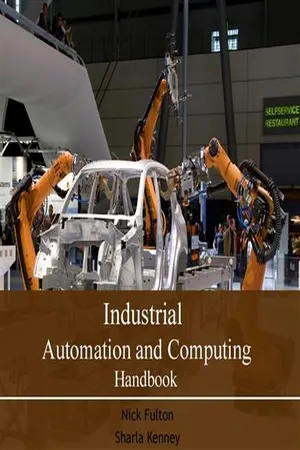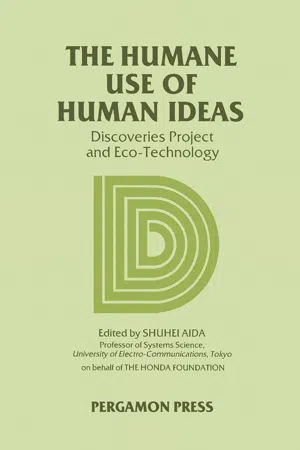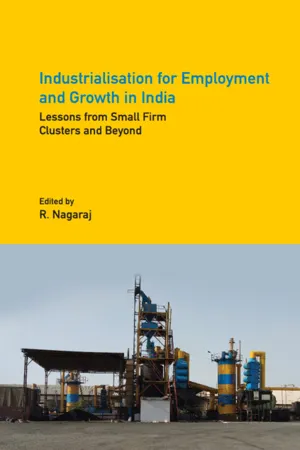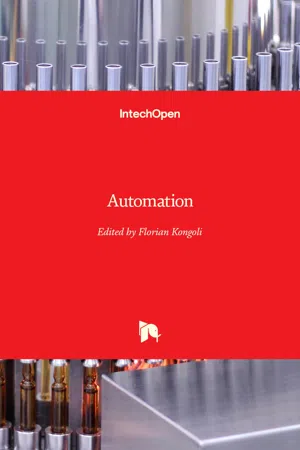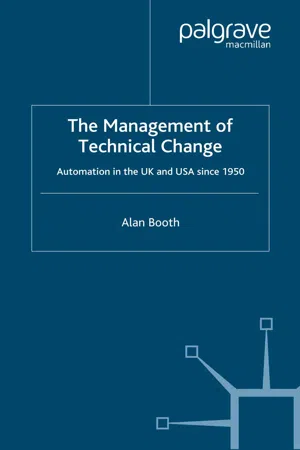Technology & Engineering
Automation
Automation refers to the use of technology and machinery to perform tasks with minimal human intervention. It involves the creation and application of systems that can operate and control processes, reducing the need for manual labor. Automation aims to improve efficiency, accuracy, and productivity in various industries by streamlining repetitive tasks and enabling the execution of complex operations.
Written by Perlego with AI-assistance
Related key terms
1 of 5
9 Key excerpts on "Automation"
- No longer available |Learn more
- (Author)
- 2014(Publication Date)
- Academic Studio(Publisher)
____________________ WORLD TECHNOLOGIES ____________________ Chapter-4 Automation KUKA Industrial Robots being used at a bakery for food production Automation is the use of control systems and information technologies to reduce the need for human work in the production of goods and services. In the scope of industrialization, Automation is a step beyond mechanization. Whereas mechanization provided human operators with machinery to assist them with the muscular requirements of work, Automation greatly decreases the need for human sensory and mental requirements as well. Automation plays an increasingly important role in the world economy and in daily experience. Automation has had a notable impact in a wide range of industries beyond manufacturing (where it began). Once-ubiquitous telephone operators have been replaced largely by automated telephone switchboards and answering machines. Medical processes such as primary screening in electrocardiography or radiography and laboratory analysis of ____________________ WORLD TECHNOLOGIES ____________________ human genes, sera, cells, and tissues are carried out at much greater speed and accuracy by automated systems. Automated teller machines have reduced the need for bank visits to obtain cash and carry out transactions. In general, Automation has been responsible for the shift in the world economy from industrial jobs to service jobs in the 20th and 21st centuries. Advantages and disadvantages The main advantages of Automation are: • Replacing human operators in tasks that involve hard physical or mono-tonous work. • Replacing humans in tasks done in dangerous environments (i.e. fire, space, volcanoes, nuclear facilities, underwater, etc.) • Performing tasks that are beyond human capabilities of size, weight, speed, endurance, etc. • Economy improvement. Automation may improve in economy of enterprises, society or most of humanity. - eBook - PDF
The Humane Use of Human Ideas
The Discoveries Project and Eco-Technology
- Shuhei Aida(Author)
- 2016(Publication Date)
- Pergamon(Publisher)
CHAPTER 10 Impacts and Characteristics of Automation and Automated Information Processing Technology R. SHIRANE Genealogy of Automation Technology is a m e a n s to assist, substitute and expand various aspects of h u m a n activities. Aristotle stated that technology m a y be divided into two categories: that derived from the spirit of labor—or the needs of real life—and that derived from the spirit of play. According to this classification, Automation is a typical technical system evolved from the spirit of labor. Since a n y attempt to trace the origin of Automation technology necessitates going back to the origin of interaction between m a n and technology, the author has limited himself to seeking the genealogy of Automation in the development of modern tech-nologies. T h e first move toward Automation w a s the introduction of automatic machines into production systems, which achieved rapid progress in the 1920s and 1930s. One of the driving forces in the m a i n s t r e a m of this trend w a s the development by H e n r y Ford of the mass production system for automobiles, which brought about a great innovation in industrial production. W i t h the idealistic slogan: T h e purpose of an enterprise should not be just to m a k e a profit, but to serve society, the flower of Fordism bloomed. Amidst intensifying conflicts between labor and m a n a g e m e n t , in a situation of severe working conditions and low 1 6 9 170 Reikichi Shirane w a g e s , Ford proposed the double and at first sight paradoxical target of low prices and high w a g e s . T h e supply of cheap good quality automobiles while p a y i n g high w a g e s to workers were clearly two objectives of great benefit to the community; but objectives which would have been m u t u a l l y exclusive without the establishment of a mass production system by automating the manufacturing processes. - J. T. Black, Ronald A. Kohser(Authors)
- 2019(Publication Date)
- Wiley(Publisher)
CHAPTER 34 656 34.1 Introduction The term Automation has many definitions. Apparently, it was first used in the early 1950s to mean automatic handling of mate- rials, particularly equipment used to unload and load stamping equipment. It has now become a general term referring to ser- vices performed, products manufactured and inspected, infor- mation handling, materials handling, and assembly—all done automatically (i.e., as an automatic operation without human involvement). In 1962, Amber and Amber presented their Yardstick for Automation, which is based on the concept that all work requires energy and information and that certain functions must be pro- vided by workers or machines. Whenever a machine function replaces a human function or attribute, it is considered to have taken a step up in an “order” of automaticity. The chart that they developed is shown in Table 34.1 with updates in bold type to account for modern terms. Notice that each order of Automation is tied to the human attribute that is being replaced (mechanized or automated) by the machine. Therefore, the A(0) level of auto- mation, in which no human attribute was mechanized, covers the Stone Age through the Iron Age. Two of the earliest machine tools were the crude lathes the Etruscans used for making wooden bowls around 700 b.c. and the windlass-powered broach for machining grooves into rifle barrels used over 300 years ago. The A(1) level and first industrial revolution are tied to the development of powered machine tools, dating from 1775 in England. The energetic, “iron-mad” John Wilkinson constructed a horizontal boring machine for machining internal cylindrical surfaces, such as piston-type pumps. In Wilkinson’s machine, a model of which is shown in Figure 34.1, the boring bar extended through the casting to be machined and was supported at its outer ends by bearings. Modern boring machines still employ this basic design.- eBook - PDF
Industrialisation for Employment and Growth in India
Lessons from Small Firm Clusters and Beyond
- R. Nagaraj(Author)
- 2021(Publication Date)
- Cambridge University Press(Publisher)
1 Thereafter, there has been a series of studies by academic economists and multilateral institutions such as the Organisation for Economic Co-operation and Development (OECD 2016) as well. 2 In the context, the purpose of the chapter is to understand the extent of the diffusion of Automation technologies in Indian manufacturing and then analyse its effects on manufacturing employment. Manufacturing and Automation 251 Concept of Automation A range of technologies are involved in industrial Automation which manifests itself as both hardware and software. Employment implications of these various Automation technologies vary considerably. The specific Automation technology that has the most direct impact on employment is the use of multipurpose industrial robots. The International Federation of Robotics – IFR for short – defines an industrial robot as ‘an automatically controlled, reprogrammable, and multipurpose [machine]’ (IFR 2014). That is, industrial robots are fully autonomous machines that do not need a human operator and that can be programmed to perform several manual tasks such as welding, painting, assembling, handling materials or packaging. Most other types of Automation technologies require a human operator, for instance, a machine tool, programmable controllers or a computer-aided design (CAD) equipment. Robots can also perform reliably and consistently in harsh and constrained environments in which a human worker cannot function satisfactorily. Robots therefore represent the most advanced and flexible form of industrial Automation that can be envisioned. So, in the present study, we focus on industrial robots. In addition to industrial robots, there are service robots as well. There are two concepts of industrial robots: delivered (flow) and operational stock (stock). Since we are interested in employment implications, our focus is on the operational stock of industrial robots in Indian manufacturing. - eBook - ePub
- Gordon Mair(Author)
- 2019(Publication Date)
- Wiley(Publisher)
Part IV Manufacturing Automation 18 Manufacturing Automation – Introduction The topic of manufacturing Automation covers a broad spectrum and this short chapter focuses on the ‘what’ and ‘why’ of Automation. In the following three chapters, the individual building blocks of Automation are initially considered, then industrial robots as an exemplar of the topic and in Chapter 21 the operation of machine vision systems is examined as these are commonly found within many areas of industry. The word ‘automatic’, was derived from the Greek automaton meaning ‘acting independently’. Although it had been used earlier, the term ‘Automation’ came into common usage in the car industry in the early to mid‐twentieth century and it implies the concept of mechanisation with the added feature of automatic control. The term ‘mechanisation’ was a prominent aspect of the Industrial Revolution that began in the eighteenth century and it refers to the application of machinery to do work previously done by humans and horses and so on. Here, we will use the term ‘manufacturing Automation’ to encompass the equipment and techniques used not only to eliminate the need for human work, as with industrial robots, but also to assist the manufacturing process more generally. 18.1 Types of Automation Dedicated Automation is used for making high volumes of the same product at high production rates for long periods of time. The type of equipment used is sometimes called ‘hard’ Automation as it is purpose built to make a specific product and the physical structure and its control are not easily changed to produce different products. Reprogrammable, or ‘soft’ Automation refers to automatic processes or equipment that can be easily reprogrammed to cope with changes in products or tasks. This type is popular due to the short life cycles of many modern products and the need to satisfy a wide range of different customer demands - eBook - PDF
- Florian Kongoli(Author)
- 2012(Publication Date)
- IntechOpen(Publisher)
The progress of IT is impressive. Things that until recently seemed fantastic, such as a device transferring mental signals to a computer, systems of three-dimensional printing and android robots hardly distinguishable from a human, have already been created and are operating. But still Automation of daily human activities remains one of the main objectives of IT. Computer systems and robotized lines perform routine, complex and dangerous operations instead of human staff. Activity fields where it was formerly impossible to manage without human control nowadays are operated by robots and unmanned machines operating with jeweller accuracy. Having freed millions of people from the necessity to work manually, at the same time IT has opened up a huge market for intellectual labour for millions of IT specialists. Moreover, Automation 340 the IT industry constantly acquires new areas and technologies, generating deeper division of labour between experts. Year on year the IT industry faces an increased array of problems, starting with technological restrictions and finishing with solutions with moral and ethical implications. Some problems are solved, while others constantly appear. Among them there is a big and important issue: who can automate the work of the one who automates the work of others? There is no universal solution. Ironic as it may be, many IT processes are extremely difficult to be automated. As an example, the process of software development, testing and support is quite creative work, despite the continuing tendency to automate the processes. This is what makes programmers, testers and support staff much like street artists. The initial requirements are a little like a client who wants a portrait painted, and the result, i.e., a finished portrait, depends on the client‘s preferences and mood, as well as on the artist’s style of painting. - eBook - ePub
A Handbook of Work and Organizational Psychology
Volume 4: Organizational Psychology
- De Charles, P J D Drenth, THIERRY HENK, Charles, De, Wolff(Authors)
- 2013(Publication Date)
- Psychology Press(Publisher)
- Computer Aided Manufacturing (CAM) in assembly—in particular, the programmable robot. At present, programmable robots are chiefly used to join parts of a product, as by welding. This is a relatively recent application of Automation to which much further refinement is needed—to the sensor systems, the control algorithms, the programmability, and the interfaces with other machines via the central computer.
- Automation of the physical distribution. Emphasis here lies on stock control and production control. Familiar examples are automated warehouses, automatically guided transport vehicles, and computer reports when stock levels become critical. An important development in this field is the linking of physical distribution systems to more general production control systems.
- Automation of control processes. These involve data processing, communication systems, and information systems at all three control levels (strategic, tactical, and operational). An important development in this field is Manufacturing Resource Planning (MRP), in which several elements have been combined with a view to optimal control and planning of the production process, so that materials and resources can be employed efficiently, ultimately to supply the products to the customer as planned. More and more information networks are also being set up between companies, to optimize the supply of products to customers and to minimize intermediate stocks. Co-makership between companies becomes a usual practice in trying to minimize losses in the whole chain of processes from raw materials to consumer.
All these types of Automation are used in industrial production systems. Automation of control processes at the three control levels is also employed in administrative information systems, such as budgeting systems, personnel information systems, and management-accounting information systems.Wentink and Zanders (1985) distinguished four types of office tasks: policy-making tasks, professional tasks, secretarial tasks, and administrative tasks. They differ from one another in the information subprocesses that make up the most important parts of the task. Examples of information subprocesses are: generating, handling, interpreting, recording, storing, retrieving, consulting, duplicating. Because they are of a more standardized and predictable nature, administrative and secretarial tasks are easier to automate than policy-making and professional tasks. The information subprocesses of interpretation and generation are among the main activities of the two latter types of tasks. This makes the application of computers more difficult, despite a growing interest in “expert systems”. Expert systems aim at the representation of the knowledge of a human expert. Very few expert systems are in use as yet, although in principle many semi-structured decision problems could be approached with the help of expert systems (Ballantine, 1988). If the user is unable to follow the decision-making process of the system, it is a considerable obstacle to the application of such systems. This is an essential condition: if the system is not able to explain its reasoning to the user, it will not be used. Another problem in the development of expert systems is specifying the knowledge. In other words, via what techniques can the knowledge be quantified? Methods have become available in recent years. Also in the field of management tasks automated information systems are being implemented, to support decision-making by managers. The adoption of these Executive Information Systems however is not so easy (see, e.g., Cullen, 1995). - eBook - PDF
The Management of Technical Change
Automation in the UK and USA since1950
- A. Booth(Author)
- 2006(Publication Date)
- Palgrave Macmillan(Publisher)
71 4 Automation in Engineering Engineering has been the key manufacturing industry of the mid- twentieth century. It is conventionally divided into vehicles, mechan- ical engineering (such as the making of machine tools, civil engineering plant), electrical and electronic engineering and instrument-making. There are, however, different national conventions about where these divisions fall, making international comparison very difficult (Saunders 1978: 11–13). Methods of production are extremely varied, and are con- ventionally divided into “mass” and “flexible” production, though each can be sub-divided and the boundaries between them are uncertain. 1 Some parts of engineering were profoundly changed by Automation in the 1950s, with the introduction of automatic transfer machines (ATMs) in “volume” branches and N/C machine tools in “specialty” produc- tion. From the early 1970s production engineers began to see the poten- tial of N/C tools and “robotics” in volume production, though this change is frequently associated with “Japanisation” (Chapter 8 below). Comparative performance of British and American engineering Despite the difficulties associated with international comparisons, we have Broadberry’s estimates of relative labour productivity in British and American engineering in Table 4.1. The data are patchy but show clearly that from 1950 until the later 1960s the average US engineering worker produced about three times as much as the UK counterpart. The engineering productivity gap was wider than for manufacturing as a whole, though it narrowed appreciably by the mid-1970s (Table 2.2). Before 1970, the better sectors include machine tools, agricultural machinery and shipbuilding (though its relative labour productivity deteriorated over the long boom). Cans and metal boxes were the B. Alan, The Management of Technical Change © Alan Booth 2006 - eBook - PDF
Safety Differently
Human Factors for a New Era, Second Edition
- Sidney Dekker(Author)
- 2014(Publication Date)
- CRC Press(Publisher)
If we automate part of a task, then the human does not carry out that part. And if the human does not carry out that part, there is no possibility of human error. As a result of this logic, there was a time (and in some quarters there perhaps still is) that automating everything we techni-cally could was considered the best idea. The Air Transport Association of America (ATA) observed, for example, that “during the 1970’s and early 1980’s... the concept of automating as much as possible was considered appropriate” (Billings 1997, p. xi). It would lead to greater safety, greater capabilities, and other benefits. Automation today not only replaces human work but also indeed extends human capabilities in many safety-critical fields. In fact, Automation is often presented and implemented precisely because it helps systems and people perform better and cheaper. It may even make operational lives easier: reducing task load, increasing access to informa-tion, helping the prioritization of attention, providing reminders, and doing work for us where we cannot. FUNCTION ALLOCATION AND THE SUBSTITUTION MYTH But can Automation, in the Taylorist sense, replace human work, thereby reducing human error? Or is there a more complex coevolution of people and technology? Engineers and others involved in Automation development are sometimes led to believe that there is a simple answer, and in fact a simple way of getting the answer. MABA-MABA lists, or “Men-Are-Better-At, Machines-Are-Better-At” lists have appeared over the decades in various guises. What these lists basically do is try to enumerate the areas of machine and human strengths and weaknesses, in order to 209 New Technology and Automation provide engineers with some guidance on which functions to automate and which ones to give to the human. The process of function allocation as guided by such lists sounds straightforward but is actually fraught with difficulty and often unexamined assumptions.
Index pages curate the most relevant extracts from our library of academic textbooks. They’ve been created using an in-house natural language model (NLM), each adding context and meaning to key research topics.
